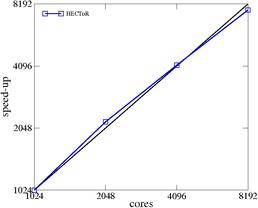Development of a novel Navier-Stokes solver (HiPSTAR)
- Started
- 1st September 2007
- Ended
- 2nd December 2013
- Investigators
- Richard Sandberg
The High-Performance Solver for Turbulence and Aeroacoustic Research (HiPSTAR) was developed as part of a Royal Academy of Engineering/EPSRC research fellowship. The full compressible Navier-Stokes equations are solved on general curvilinear coordinates, with the option of also solving curvilinear cylindrical coordinates. The structured, multi-block code is tailored to be particularly efficient for modern HPC systems by making a significant effort to minimize the memory requirement in light of severe bandwidth limitations imposed by current multi core architectures. The code includes the following features: i) highly optimized (wavenumber resolution) 4th-order accurate parallelized compact differences, ii) a spectral method for the spanwise or azimuthal direction (in the case of cylindrical coordinates enabling a state-of-the-art axis treatment that exploits parity conditions of individual Fourier modes), iii) ultra low-storage 4th-order Runge-Kutta time integration, iv) skew-symmetric splitting of the nonlinear terms, v) non-reflective characteristic boundary conditions, vi) characteristic interface conditions for the connection of blocks with metric discontinuities, vii) a time dependent immersed boundary method for the realization of complex and/or moving geometries, and viii) domain decomposition in the two finite-difference directions using an MPI parallelization. The parallel efficiency of HiPSTAR has been extensively tested on various computing platforms and production runs have to date been performed on 14,208 cores. In a CRAY centre of excellence project (http://www.hector.ac.uk/coe/pdf/HiPSTAR_OMP_Report.pdf), the code was converted to a hybrid OMP/MPI parallelisation, where the OMP parallelisation was applied to the direction in which the spectral method is employed.
Categories
Physical Systems and Engineering simulation: Acoustics, CFD
Algorithms and computational methods: FFT, Finite differences, Multi-core, Multi-scale
Simulation software: HiPSTAR
Visualisation and data handling software: ParaView, TecPlot, VisIt, Xmgrace
Software Engineering Tools: CVS, SVN
Programming languages and libraries: Fortran
Computational platforms: Emerald, GPU, HECToR, Iridis
Transdisciplinary tags: HPC, Scientific Computing, Software Engineering
